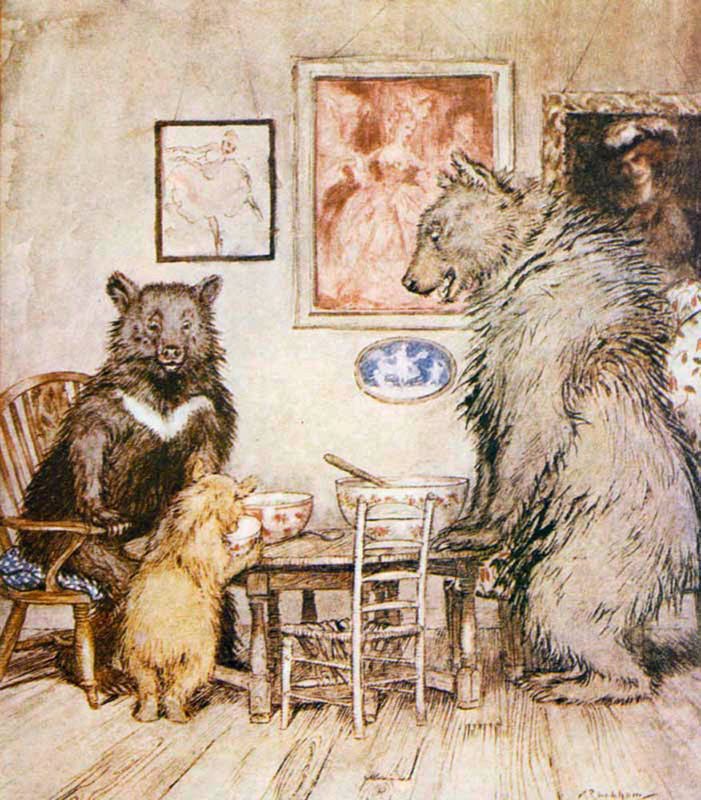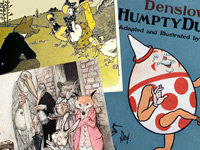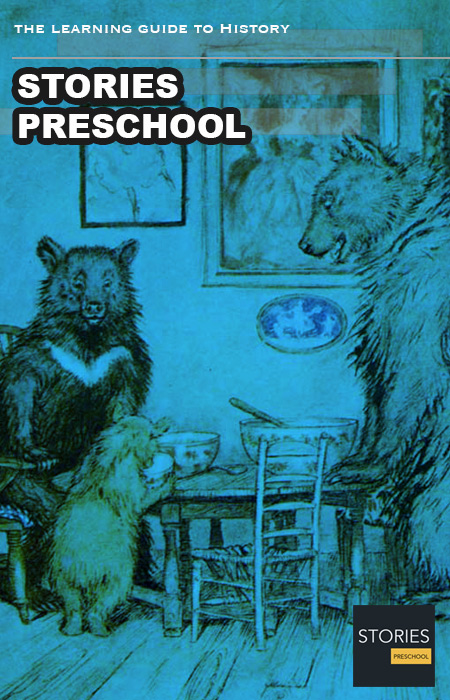Goldilocks and the Three Bears

"Goldilocks and the Three Bears" and the older "The Story of the Three Bears" are two variations of an old fairy tale. The original tale tells of an ugly, old woman who enters the forest home of three bachelor bears whilst they are away. She sits in their chairs, eats some of their porridge, and falls asleep in one of their beds. When the bears return and discover her, she starts up, jumps from the window, and is never seen again. The other major version brings Goldilocks to the tale (replacing the old woman), and an even later version retained Goldilocks, but has the three bachelor bears transformed into Papa, Mama, and Baby Bear.
What was originally a fearsome oral tale became a cosy family story with only a hint of menace. The story has elicited various interpretations and has been adapted to film, opera, and other media. "The Story of the Three Bears" is one of the most popular fairy tales in the English language.
Plot
In Southey's tale, three anthropomorphic bears – "a Little, Small, Wee Bear, a Middle-sized Bear, and a Great, Huge Bear" – live together in a house in the woods. Southey describes them as very good-natured, trusting, harmless, tidy, and hospitable. Each of these "bachelor" bears has his own porridge bowl, chair, and bed. One day they take a walk in the woods while their porridge cools. A woman approaches the bears' house. As she has been sent out by her family, since she is a disgrace to them. She is described at various points in the story as impudent, bad, foul-mouthed, ugly, dirty, and a vagrant deserving of a stint in the House of Correction. She looks through a window, peeps through the keyhole, and lifts the latch. Assured that no one is home, she walks in. The old woman eats the Wee Bear's porridge, then settles into his chair and breaks it. Prowling about, she finds the bears' beds and falls asleep in Wee Bear's bed. The climax of the tale is reached when the bears return. Wee Bear finds the old woman in his bed and cries, "Somebody has been lying in my bed, – and here she is!" The old woman starts up, jumps from the window, and runs away never to be seen again.
Origins
The story was first recorded in narrative form by British writer and poet Robert Southey, and first published anonymously in 1837 in a volume of his writings called The Doctor. The same year, British writer George Nicol published a version in rhyme based upon Southey's prose tale, with Southey approving Nicol's attempt to give the story more exposure. In 1849, Joseph Cundall introduced a pretty little girl to the story and dispensed with the old woman. Cundall believed there were already too many tales with old women playing roles in the narrative.
The story of the three bears was in circulation before the publication of Southey's tale. In 1813, for example, Southey was telling the story to friends, and in 1831 Eleanor Mure fashioned a handmade booklet about the three bears and the old woman for her nephew's birthday, In 1894, "Scrapefoot", a tale with a fox as antagonist that bears striking similarities to Southey's story, was uncovered by the folkloristJoseph Jacobs and may predate Southey's version in the oral tradition. Southey possibly heard "Scrapefoot", and confused its "vixen" with a synonym for an unpleasant malicious old woman. Some maintain however that the story as well as the old woman originated with Southey.
"The Story of the Three Bears" experienced two significant changes during its early publication history. The intrusive little girl was given various names referring to her hair until Goldilocks was settled upon once and for all in the early 20th century. Southey's three bachelor bears evolved into Papa, Mama, and Baby Bear over several years.
In 1837, Robert Southey published "The Story of the Three Bears" in his collection of essays and miscellanea entitled The Doctor. The tale was not an original creation by Southey, but was a retelling of a story that had long been in circulation. Southey had been telling the story to others as early as September 1813, and in 1831 Eleanor Mure versified the tale as a birthday gift for her nephew Horace Broke.
Southey and Mure differ in details. Southey's bears have porridge, but Mure's have milk; Southey's old woman has no motive for entering the house, but Mure's old woman is piqued when her courtesy visit is rebuffed; Southey's old woman runs away when discovered, but Mure's old woman is impaled on the steeple of St Paul's Cathedral.
Southey most likely learned the tale as a child from his uncle William Tyler. Tyler may have told a version with a vixen (she-fox) as intruder, and Southey later confused vixen with a common appellation for a crafty old woman. P.M. Zall writes in "The Gothic Voice of Father Bear" (1974) that "It was no trick for Southey, a consummate technician, to recreate the improvisational tone of an Uncle William through rhythmical reiteration, artful alliteration ('they walked into the woods, while'), even bardic interpolation ('She could not have been a good, honest Old Woman')". Ultimately, it is uncertain where Southey or his uncle learned the tale.
The same year Southey's tale was published, the story was versified by George Nicol who acknowledged the anonymous author of The Doctor as "the great, original concocter" of the tale. Southey was delighted with Nicol's effort to bring more exposure to the tale, concerned children might overlook it in The Doctor. Nicol's version was illustrated with engravings by B. Hart (after "C.J."), and was reissued in 1848 with Southey identified as the story's author.
Folklorists Iona and Peter Opie point out in The Classic Fairy Tales (1999) that the tale has a "partial analogue" in "Snow White": the lost princess enters the dwarfs' house, tastes their food, and falls asleep in one of their beds. In a manner similar to the three bears, the dwarfs cry, "Someone's been sitting in my chair!", "Someone's been eating off my plate!", and "Someone's been sleeping in my bed!" The Opies also point to similarities in a Norwegian tale about a princess who takes refuge in a cave inhabited by three Russian princes dressed in bearskins. She eats their food and hides under a bed.
In 1865, Charles Dickens referenced a similar tale in Our Mutual Friend, but in Our Mutual Friend, the house belongs to hobgoblins rather than bears. Dickens' reference however suggests a yet to be discovered analogue or source. Hunting rituals and ceremonies have been suggested and dismissed as possible origins.
In 1894, the illustrator John D. Batten reported a variant of the tale at least 40 years old. In this version, the three bears live in a castle in the woods and are visited by a fox called Scrapefoot who drinks their milk, sits in their chairs, and rests in their beds. This version belongs to the early Fox and Bear tale-cycle.
Later variations: Goldilocks
Twelve years after the publication of Southey's tale, Joseph Cundall transformed the antagonist from an ugly old woman to a pretty little girl in his Treasury of Pleasure Books for Young Children. He explained his reasons for doing so in a dedicatory letter to his children, dated November 1849, which was inserted at the beginning of the book:
The "Story of the Three Bears" is a very old Nursery Tale, but it was never so well told as by the great poet Southey, whose version I have (with permission) given you, only I have made the intruder a little girl instead of an old woman. This I did because I found that the tale is better known with Silver-Hair, and because there are so many other stories of old women.
Once the little girl entered the tale, she remained – suggesting children prefer an attractive child in the story rather than an ugly old woman. The juvenile antagonist saw a succession of names: Silver Hair in the pantomime Harlequin and The Three Bears; or, Little Silver Hair and the Fairies by J.B. Buckstone (1853); Silver-Locks in Aunt Mavor's Nursery Tales (1858); Silverhair in George MacDonald's "The Golden Key" (1867); Golden Hair in Aunt Friendly's Nursery Book (ca. 1868); Silver-Hair and Goldenlocks at various times; Little Golden-Hair (1889); and finally Goldilocks in Old Nursery Stories and Rhymes (1904). Tatar credits Flora Annie Steel with naming the child (1918).
Goldilocks's fate varies in the many retellings: in some versions, she runs into the forest, in some she is almost eaten by the bears but her mother rescues her, in some she vows to be a good child, and in some she returns home. Whatever her fate, Goldilocks fares better than Southey's vagrant old woman who, in his opinion, deserved a stint in the House of Correction, and far better than Miss Mure's old woman who is impaled upon a steeple in St Paul's church-yard.
Southey's all-male ursine trio has not been left untouched over the years. The group was re-cast as Papa, Mama, and Baby Bear, but the date of this change is disputed. Tatar indicates it occurred by 1852, while Katherine Briggs suggests the event occurred in 1878 with Mother Goose's Fairy Tales published by Routledge. With the publication of the tale by "Aunt Fanny" in 1852, the bears became a family in the illustrations to the tale but remained three bachelor bears in the text.
In Dulcken's version of 1858, the two larger bears are brother and sister, and friends to the little bear. This arrangement represents the evolution of the ursine trio from the traditional three male bears to a family of father, mother, and child. In a publication ca. 1860, the bears have become a family at last in both text and illustrations: "the old papa bear, the mama bear, and the little boy bear". In a Routledge publication c 1867, Papa Bear is called Rough Bruin, Mama Bear is Mammy Muff, and Baby Bear is called Tiny. Inexplicably, the illustrations depict the three as male bears.
In publications subsequent to Aunt Fanny's of 1852, Victorian nicety required editors to routinely and silently alter Southey's "[T]here she sate till the bottom of the chair came out, and down came her's, plump upon the ground" to read "and down she came", omitting any reference to the human bottom. The cumulative effect of the several changes to the tale since its original publication was to transform a fearsome oral tale into a cozy family story with an unrealized hint of menace.
Literary elements
The story makes extensive use of the literary rule of three, featuring three chairs, three bowls of porridge, three beds, and the three title characters who live in the house. There are also three sequences of the bears discovering in turn that someone has been eating from their porridge, sitting in their chairs, and finally, lying in their beds, at which point is the climax of Goldilocks being discovered. This follows three earlier sequences of Goldilocks trying the bowls of porridge, chairs, and beds successively, each time finding the third "just right". Author Christopher Booker characterizes this as the "dialectical three", where "the first is wrong in one way, the second in another or opposite way, and only the third, in the middle, is just right." Booker continues "This idea that the way forward lies in finding an exact middle path between opposites is of extraordinary importance in storytelling". This concept has spread across many other disciplines, particularly developmental psychology, biology, economics and engineering where it is called the "Goldilocks Principle".
LITERATURE FAIRY TALES

The Three Bears - Project Gutenberg eText 17034

The Three Bears - Project Gutenberg eText 17034
( Click image to enlarge)
A fairy tale is a type of short story that typically features folkloric fantasy characters, such as dwarves, elves, fairies, giants, gnomes, goblins, mermaids, trolls, or witches, and usually magic or enchantments. Fairy tales may be distinguished from other folk narratives such as legends (which generally involve belief in the veracity of the events described) and explicitly moral tales, including beast fables. The term is mainly used for stories with origins in European tradition and, at least in recent centuries, mostly relates to children's literature.
Read More » List of Fairy tales »
RESOURCES
This article uses material from the Wikipedia articles "List of fairy tales", "Fairy tale" and "Goldilocks and the Three Bears", which is released under the Creative Commons Attribution-Share-Alike License 3.0.
© Stories Preschool. All Rights Reserved.






